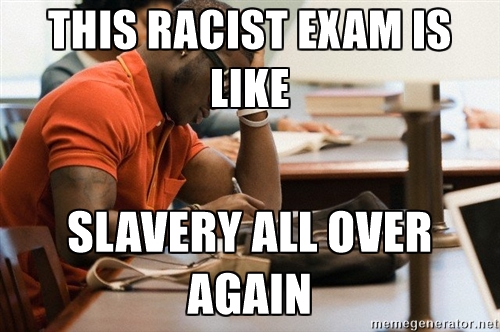Diversity Macht Frei
January 17, 2017
This peerless example of Blame Whitey reads like a parody of political correctness. But it’s real. It is a report from a student association on the poor performance of brown-skinned students at the School of Oriental and African Studies at the University of London. (link)
The most obvious explanation – that the brown students have fewer of the qualities that lead to academic success such as intelligence, capacity to concentrate, willingness to work hard – is discounted in the first paragraph.
The BME Attainment Gap project was conducted as studies show that there has been a gap between the degree attainment of white and BME (Black and Minority Ethnic) undergraduates at SOAS, with a greater proportion of white students attaining either a 2:1 or first class degree. These gaps cannot be attributed to differences between students at entry at SOAS, thus suggesting factors within SOAS contributing to this finding. The gap is not attributable to a deficit in BME students: any intervention must target institutional factors and not BME students themselves.
How do we know the problem is not the students themselves? No explanation is offered. It is simply stated as a dogma.
More BME participants highlighted the impact of the ‘whiteness’ of the curriculum than that of any other aspect of learning and teaching. (This was followed closely by comments on the underrepresentation of people of colour and ethnic minorities among teaching staff, relative to the student body.) The underrepresentation of people of colour (and to a lesser extent, women) in course reading lists was a prominent concern, and especially that of Black scholars, both of the African continent and diaspora. Some also highlighted the overrepresentation of male authors. The lack of diversity in reading lists felt “othering”, “alienating” and “erasing” for a number of students, and for some it was difficult to relate to the perspectives centred. This had led some students to expect that, were they to contribute non-eurocentric perspectives and experiences, these would be less valued.
Too many Europeans teaching at a European university.
This message was further reinforced for many by the underrepresentation of people of colour – most notably Black people, and Black women especially – among the teaching staff relative to the student body, or as one participant described it, “white teachers teaching white students about black/brown people.” Underrepresentation was a recurring theme throughout the research and made many students feel isolated. Students connected this to their mental health, their ability to engage with their studies, and their motivation to continue.
Negroes wanted to talk street but because of “structural racism” they were forced to use proper grammar and big words, which alienated them.
Some BME students felt silenced also by the pressure to communicate using academic language that – for reasons of structural racism – was closer to the everyday speech of middle-class, white students than to their own. One BME student reported having their accent “corrected”. Another said they had peers who expected to be perceived as less intelligent on the basis of racist, classist stereotypes, and some felt their choice was between adopting the language of their white, middle-class peers or not speaking at all.
Because Whitey was allowed to speak, brown people were excluded.
A great many BME participants shared experiences of seminar discussions being dominated by white students, and of the effects on their confidence to participate. BME female students often spoke of discussions being dominated or “shut down” by white, male students, which sometimes made them feel “uncomfortable”, “intimidated” or “threatened”. A few said that when they contributed their own perspectives to class discussion, their white, male peers “belittled” and “stigmatised” them for seeming “aggressive” or “annoying”, building on racist, sexist expectations of men-of-colour (and especially Black men) as aggressive, and women-of-colour as submissive. This caused “stress and anxiety” for some female, BME students, reducing their opportunity to participate, and their confidence and motivation. Having white students’ voices dominate was especially frustrating when the discussion was about the political or theoretical interventions of people of colour, or about racist violence. Sometimes it was the way in which white students discussed these topics, for example trivialising their significance or presuming to be an expert, which excluded some BME students from participating.
The failure of teaching staff to rebuke white students for their racism meant that brownskins were “effectively censored”.
Tutors were seen to play a critical role in shaping the dynamics of class discussions, as a function of both their responsibility as discussion facilitators and of their perceived authority in the classroom. Sometimes they passively enabled white students to dismiss others’ experiences by neglecting to intervene. Some participants attributed this to their tutors perhaps feeling obliged to maintain what might appear to be freedom of speech. Whether this was the reason or not, the consequence of not intervening was that BME students remained effectively censored.
Crazy brown people not getting the “crazy discount” that is their due.
The most frequently perceived area of training need for teaching staff was in understanding and catering to the learning needs of students with mental health problems. Although relevant to students of all backgrounds, some BME participants cited anxiety and depression linked to their experiences of racism and racial discrimination; these add to the mental health risk factors shared with white students.
The crushing burden of Whitey’s racism continues to weigh heavily on those who are swart of skin, stifling their human potential and de facto perpetuating slavery and colonialism into the present day. We white people should be ashamed.
 Daily Stormer The Most Censored Publication in History
Daily Stormer The Most Censored Publication in History



